
Contact

Home
Murrumbidgee Bunyip
THE BUNYIP AGAIN.
Wagga Wagga Express and Murrumbidgee District Advertiser (NSW)
Date: December 1, 1866
Page Number: 4
It has frequently been reported that a bunyip has been seen in the Murrumbidgee River, and on Sunday morning last, as Messrs. R. Davis and McJannett, who went down to the Cavan crossing-place to fish, were examining their lines they saw what they supposed to be the oft spoken of bunyip. Mr. Davis who was the first to see it, describes it to be much larger than a young calf, with a great bushy head, thick lips, and ears longer than any blood hound; its body was round and smooth, and about eighteen inches broad. It first made its appearance above water, at distance of not more than forty yards from where they had made their camp the night previous and swam to the opposite bank, getting out on a sand bank in the midst of weeds find young oak trees, which only prevented his awe-struck spectators from crossing the river and making an attempt to effect his capture.—Goulbourn Argus.

22-08-2014
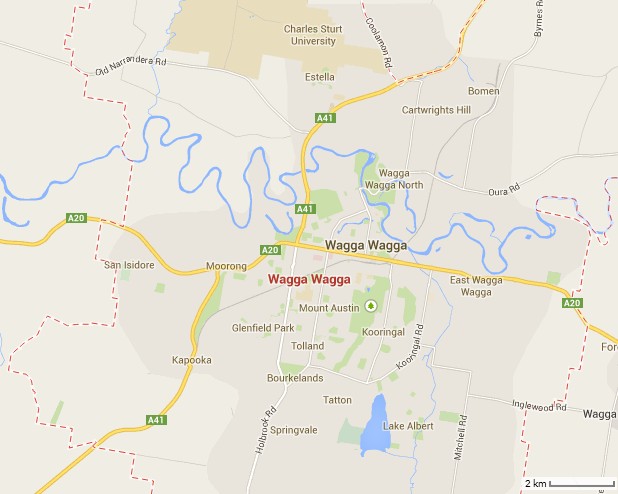

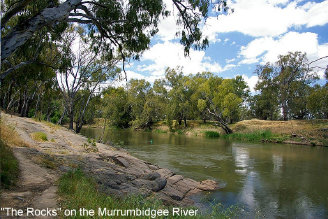
The original inhabitants of the Wagga Wagga region were the Wiradjuri people. In 1829, Charles Sturt became the first European explorer to visit the future site of the city. Squatters arrived soon after, leading to conflict with the indigenous inhabitants. The town, positioned on the site of a ford across the Murrumbidgee, was surveyed and gazetted as a village in 1849 and the town grew quickly after. In 1870, the town was gazetted as a municipality.
THE BUNYIP.
Wagga Wagga Advertiser and Riverine Reporter (NSW)
Date: November 11, 1868
Page Number: 3

The following report is furnished to the Western Times by a gentleman residing in the Cobden district, who lent his rifle to the sportsman,
and for the purpose therein mentioned. We therefore publish it for general information :—
The residents of
Cobrico have for the past week or two had a stranger among them, who has for the time being put an effectual stop to all eel fishing
0n the lake—a sport that was nightly indulged in by the youth of the neighbourhood previous to his advent. Issuing from the swamp
may now be heard continually his most dismal cries, and that hollow unearthly voice can proceed from no other than the presumedly
capacious jaws of that horror of black mankind, the bunyip. Although he gives mouth mostly of an evening, his loud oo-oop, given generally
three times in succession, is also heard during the day, but at longer intervals. At such times his whereabouts in the wide expanse
of reeds and rushes might easily be discovered to effect a capture was made a few days ago, the hunter being armed with a rifle and
accoutred for the occasion. Stalking for the spot whence the sound proceeded, he made it at length in three feet of water. Here "he
lay low and kept dark," and was carefully examining his priming to see that all was right for the expected onslaught, when he was
of a sudden so startled on hearing the roaring of the enemy close to him, followed by a rapid paddling as of a steamer, that in the
excitement of the moment, not being at all sure but that the monster was making for him, he lost his footing, going in up to his chin,
and it is needless to add, before he could resume his perch on the tussock the quarry had vanished. It is now five years since those
waters were last visited by this individual, since which time this particular "wail " has not been heard. Unfortunately there is no
boat on the Cobrico at the present time, or there is no doubt that attempts would be made daily, either by one party or another to
land this specimen of what is erroneously considered to be of the mythic family, the bunyip.
THE BUNYIP.
Wagga Wagga Advertiser and Riverine Reporter (NSW)
Date: November 13, 1868
Page Number: 2-3

To the Editor of the Wagga Wagga Advertiser.
SIR,—Foreign writers of sensational paragraphs have their "great
sea serpents," which they can "draw upon" and draw out to any length the susceptibilities of the public may demand. Colonial paragraph-inventors
have long excelled in the manufacture of "snake stories," and so "the trail of the serpent is over them all."
Latterly, however, it has become a sine qua non with every district professing to be represented by a "local" to possess a "Bunyip,"
and accordingly Mudgee follows suit on Gundagai, in claiming ownership to one of these supposed apocryphal non-descripts. One or two
strong attempts have been made to identify a Bunyip with this district, but unhappily for our credit, they have failed.
The Western Times, I observe (by your quotation of Wednesday last), indicates the establishment of a Bunyip in a lake in the Mudgee
district, near a place called Cobrico. "Where ignorance is bliss, it is folly to be wise," and the oblivion of error is sometimes
much more satisfactory in its results than the light of knowledge.
I am sorry to dispel the fascination which
has bound up the souls of the intelligent people of "Cobrico" and the correspondent of the Western Times, but there can be no doubt
that the monster which, "five years ago," threatened the destruction of all Cobrico, and has "again made his appearance" (or rather
asserted his presence by his fearful bellowing in the lake), is a harmless, stupid bittern, a bird whose sad and hollow moaning call,
by night amongst the reeds and rushes of marshes and swamps, in the old country, has sent many an awe-struck yokel to his pillow to
dream of ghosts and goblins, paddling their white canoes on "the lake of the dismal swamp." In reference to this bird and the peculiar
effect of its solemn cry, 0ne of the English poets (Thomson, I think) says :—
"The booming bittern shakes
the sounding marsh."
The bird is very common in the colony, and was plentiful about Wagga Wagga until cattle
destroyed the cover which the reeds and rushes of the swamps and lagoons once furnished abundantly, and its deep, hollow, tremulous,
"booming" cry, which (with a ventriloquistic effect) appears to fill the air, without enabling you to detect its direction always,
has certainly an impressive effect when heard in the stillness of night, in the depths of dark and dreary swamps. The call is generally
repeated twice or thrice, at moderate intervals, but seldom after midnight. The male bird alone possesses the power of uttering the
call, and never indulges in it by day except in breeding seasons, and when the cover is very dense.
If the
Cobrican hero will lay aside his rifle, abandon his water-stalking by night, and throw a couple of lively "cockers" into the lake
sedges, the dreadful Bunyip will soon discover himself, I have no doubt. Having made an acquaintance with the simple and innocent
creature, which so greatly alarmed them, the people of Cobrico, like Bloomfield's ghost-scared matrons, may soon "learn to love the
sounds that frightened them before."
Yours truly, JERRIGORAT.
Wagga Wagga, Nov. 13, 1868.
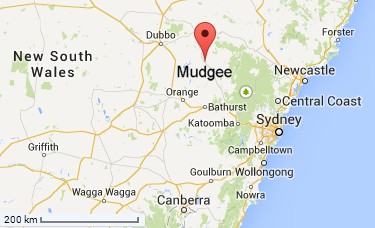
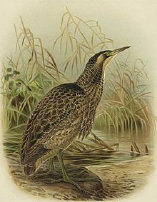

Brown Bittern
The bittern is elusive, skulking away in the reeds, with a plumage designed to help them camouflage themselves. Their habit of pointing
their heads to the sky, revealing the striped plumage on their necks helps them blend in to the surrounding reeds. If we find it difficult
to see them, other bitterns have the same problem. This is the main reason for their characteristic boom. It's an advertisement to
tell the female bitterns just where in the reedbed the male is. The low frequency is infra-sound, the same as that used by lions and
elephants to communicate over the African plains.
5 December 1868 - Mentioned that the steamer 'Bunyip' had trouble servicing Wagga without a wharf.

Bunyip. Vessel of 277 tons. Built in 1858 as a double hulled vessel and when rebuilt in 1862 was converted to a single hulled
stem-wheeler. Together with two barges, completely destroyed by fire about eleven kilometres above Chowilla Station, Murray River,
8 December, 1866. Two members of the crew and a child passenger lost their lives and most others on board suffered burns.
HAY.
Wagga Wagga Advertiser and Riverine Reporter (NSW)
Date: January 16, 1869
Page Number: 2

...
Returning homewards in the evening, drifting leisurely down the crystal stream, and the time enlivened by the jolly singing or
rattling talk of the excursionists, suddenly one of them descried something in the distance ahead, near the margin of the river. It
was moving and was unlike any thing seen before. A gun was levelled, loaded with ball, and fired. The strange thing disappeared in
the waters, and seemingly moved away. But all were convinced or at least firmly believed they had been gratified with a sight of the
terrible Bunyip. Bunyip was the talk after that homewards, where the party arrived in time to polish off an excellent dinner, at Host
Cox's. The discussion of politics, the smoking of pipes, and the drinking colonial wine wound up the day. Finally, the night-cap ;
thence to bed.



Hay is a town in the western Riverina region of south western New South Wales, Australia. It is the administrative centre of Hay Shire local government area and the centre of a prosperous and productive agricultural district on the wide Hay Plains.
The town itself is built beside the Murrumbidgee River, part of the Murray-Darling river system; Australia's largest.
While the account on the right did not occur on the Murrumbidgee it is included here because it was reported in Wagga - thereby influencing the "Bunyip-lore" of the region.
Wagga Wagga Advertiser and Riverine Reporter (NSW)
Date: April 3, 1869
Page Number: 2

...
The choice will be between the qualified and the disqualified, and it will be our own fault if we take the bad article when
we can get the good. There may be some difficulty, perhaps, in getting exactly what we want, for
human nature is never perfect, and
the model Alderman is as yet as purely a creature of the fancy as the bunyip. But there should be no difficulty an rejecting what
we do not want, and as it may possibly assist us in dealing with an objectionable candidate to have him clearly defined, we will take
the trouble to define him.
SYDNEY GOSSIP.
Wagga Wagga Advertiser and Riverine Reporter (NSW)
Date: May 1, 1869
Page Number: 2

[FROM OUR OWN CORRESPONDENT.]
Wednesday, April 28.
ONCE upon a time, and not long ago, there flourished, or
vegetated, in the lively city of Newcastle, at the mouth of the River Hunter, a weekly newspaper of diminutive proportions, the conductor
of which appeared to be in a constant state of trepidation at the immense weight of responsibility resting upon his shoulders as thunder-manufacturer
for the journal in question. I remember that on one occasion he delivered himself to something like the following effect:—
"We are never more deeply-impressed with the responsibility of the task imposed upon us than when we sit down to prepare our summary
article for the English mail." Now, this poor man, who seemed to be under the impression that the eyes of Europe were upon him and
his leaders, was not more filled with awe and apprehension at his position, than I am in approaching, for the first time, the people
of Wagga Wagga. That dim, mysterious region lived in my memory first from a belief, founded upon sundry paragraphs and rumours, that
its river was haunted by a Bunyip, of vagrant habits and late hours, which Bunyip, if it did not, like the ghost of Herne the hunter,
"Walk all night round a tree, and shake a chain,
In a most hideous and dreadful manner,"
did, nevertheless, alarm
and terrify the traveller by night by splashing in the water, bellowing like a calf, and indulging in other uncivilised and disorderly
proceedings. Then when I endeavoured to find out something about the Murrumbidgee River itself, I could get no other information but
what was conveyed in a sportive effusion by a local poet, which I read in one of the Southern papers a few years ago, and which imitates
the "Groves of Blarney" after the following fashion :
"Oh the Murrumbidgee, sure its a pity,
Some famous city a'nt on its shores;
Where ship and houses might bring in thousands
And streets be crowded with merchant's stores."
You will
perceive that the rhyming is slightly, very slightly, defective; but the noble patriotism of the aspiration makes up for a host of
small foibles. So my impressions have remained until this time ; and now I am called upon to realise. Wagga Wagga ! Phoebus, what
a name ! The very sound of it is suggestive of such an amount of waggery on the part of the people as would sufiice, if fired upon
the small craft which I am now about to launch, to sink it, "full fathom five," in much less time than it took the Keersage to settle
the business of the Alabama. But never mind. Couragio ! I will trust to the generosity of the people towards a green hand, and to
your skilful pilotage ; so here goes...
23-08-2014

Originally a monthly publication, the first issue of "The Bunyip", subtitled "Gawler Humbug Society's Chronicle" was issued on 5 September
1863, consisted of 8 pages and was priced at 6d. It was warmly greeted by the South Australian Register,observing that it was "full
of racy articles and local hits ... a very humorous article on the Gawler Agricultural Society's last dinner, which (was) not only
very amusing but strictly correct ... (and should) undoubtedly prove a great success."
With the paper's success, publication increased to bi-monthly in February 1865 (there was none printed in January), appearing on the
first and third Saturday of each month. With new printing machinery, the paper upsized to broadsheet format. And its title had become
The Bunyip or Gawler Chronicle and Northern Advertiser. The following year it became a weekly. By this time however, the paper's original
offbeat stance had quite vanished and it had become a regular newspaper.
observing that it was "full of racy articles and local hits ... a very humorous article on the Gawler Agricultural Society's last
dinner, which (was) not only very amusing but strictly correct ... (and should) undoubtedly prove a great success."
With the
paper's success, publication increased to bi-monthly in February 1865 (there was none printed in January), appearing on the first
and third Saturday of each month. With new printing machinery, the paper upsized to broadsheet format. And its title had become The
Bunyip or Gawler Chronicle and Northern Advertiser. The following year it became a weekly. By this time however, the paper's original
offbeat stance had quite vanished and it had become a regular newspaper.
THE BUNYIP AGAIN.
Wagga Wagga Advertiser and Riverine Reporter (NSW)
Date: July 2, 1870
Page Number: 4

THE Australian bunyip, like the American sea serpent, is always obliging enough to make an appearance when things are rather dull
and current topics somewhat scanty and uninteresting, and also, and that is a peculiar piece of consideration, when the season of
the year does not afford the snake incidents which country journalists so love to chronicle. The monster's last, appearance was in
the neighbourhood of Dubbo, and is faithfully and minutely recorded in the Manaroo Mercury. It seems that two residents had to leave
their places by the river and go to a hut on higher ground to avoid the encroaching floods. While sitting by a log fire they heard
a crash, "like rumbling thunder," in the direction of the river. Says one, "Ah me ! there's at least half an acre of my ground tumbled
into the river." The sound being repeated, the two men, in whom it is agreeable to read the writer has "the fullest confidence," went
to the hut door and looked "through the darkness" towards the river. They state that they saw "a huge monster clinging to a very tall
and stout tree of the eucalypti species," in fact, a gum tree. "Its head was like an elephant's, only the two tusks projected—one
from between its eyes, the other, smaller, a little above the nostrils. The only eye they could see was like a ball of fire. The body
was scaly, like the crocodile's; the fore limbs long, the talons about ten times as large as a Bengal tiger's." All this they saw
very minutely "through the darkness," the light being probably supplied by the "eye-ball of fire." As "the river continued to rise,
the bunyip held more tenaciously to the tree, and grinned his teeth occasionally, as if in fear or danger. Once he lashed his tail,
and on striking the water the noise was like a diminutive sound of Niagara. The river still rose, but a limb in the tree prevented
the monster from crawling up further. There was a struggle to get higher, but this effort brought down the tree which he was clasping
right over him, and both seemed to float quietly down the Macquarie." And, like the Dogberry, they no doubt "thanked heaven that they
were well rid of a knave." It would appear from the above reliable narrative that the bunyip has got considerably bigger since his
former appearance.

Population growth was slow until the Victorian gold rush of the 1860s brought an increase in north-south trade. The first bank was opened in 1867. Steady population growth saw the town proclaimed a municipality in 1872, when its population was 850. The railway extension of the main western railway from Wellington to Dubbo was formally opened on 1 February 1881.

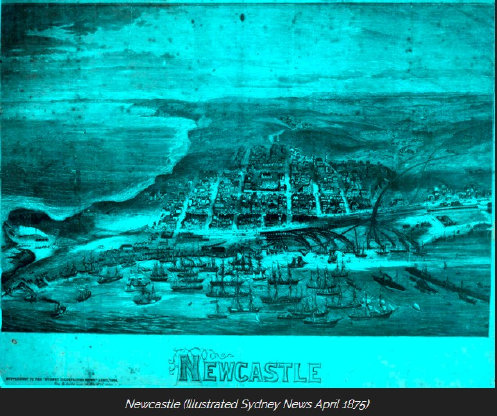
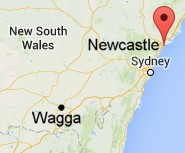
Newcastle and the lower Hunter Region were traditionally occupied by the Awabakal and Worimi Aboriginal People, who called the area
Malubimba.

In English folklore, Herne the Hunter is a ghost associated with Windsor Forest and Great Park in the English county of Berkshire. He has antlers upon his head.
The first literary mention of Herne is in William Shakespeare's play, The Merry Wives of Windsor, though there are several theories attempting to place the origins of Herne as predating any evidence for him by connecting his appearance to pagan deities or ancient archetypes.
Herne has appeared in various books, TV series and other media since his first mention by Shakespeare.
Wagga Wagga Advertiser and Riverine Reporter (NSW)
Date: May 24, 1871
Page Number: 2

24-08-2014
The mysterious burglars who seem as difficult to get a sight of as "Mrs. Harris," or the Bunyip, have again been heard of. After tapping at sundry windows, knocking at sundry doors, and otherwise amusing themselves as no burglars beforo ever did, they are said to have wound up on Sunday night by breaking into an empty Church. The story as it has reached us is, that on Monday morning Mr. J. D. Thomson noticed that the door of the Church was open. Thinking that something was wrong he went up and found that an entrance had been forced through one of the windows, and the vestry-room ransacked. Everything in the room was in great disorder, but nothing was missing, for the reason, doubtless, that there was nothing of any value to take. Th Communion plate is not kept in the Church, and the thieves found nothing more tempting to their hands than the Ministers' surplice and cassock and a few prayer books, which they naturally considered not in their line.
THE BUNYIP AGAIN.
Wagga Wagga Advertiser and Riverine Reporter (NSW)
Date: September 20, 1871
Page Number: 2

The mystery that has attended the existence of the bunyip will now perhaps be elucidated :—A Stratford correspondent of the Gipps
Land Mercury states that a few days ago the Rev. Mr. Hagenauer and some blackfellows caught a veritable bunyip near Lake Tvers. The
animal is of a drab colour, with white spots. It is about 8ft. long, and about 34in. in circumference near the fore flippers. It resembles
a seal, but without a doubt it is the animal which the blacks have often expressed terror of, and whose roaring has been the cause
of so much mystery. The Rev. Mr. Hagenauer will send the creature to Melbourne for exhibition.


Friedrich August Hagenauer
Birth: 10 March 1829 Hohenleuben, Saxony, Germany
Death: 28 November 1909 Lake Tyers, Victoria, Australia
Cultural Heritage: German
Religious Influence: Moravian
Occupation: Indigenous culture recorder, Moravian missionary, Moravian priest
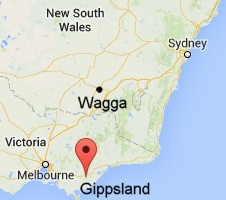
Gippsland is an economic rural region located in the east of the Australian state of Victoria. The 41,556-square-kilometre (16,045 sq mi) region lies to the east of the eastern suburbs of Greater Melbourne, to the north of Bass Strait, to the west of the Tasman Sea, to the south of the Black-Allan Line that marks part of the Victorian/New South Wales border, and to the east and southeast of the Great Dividing Range that lies within the Hume region and the Victorian Alps. The region is best known for its primary production such as mining, power generation and farming as well as its tourist destinations.

The same article was published previously on Sept 11, 1871, in the Geelong Advertiser (Vic) but there is no further indication that
Hagenauer's Bunyip/seal was ever put on display.
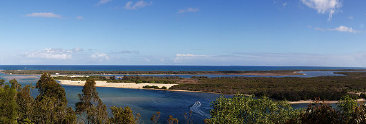
THE BUNYIP AGAIN.
Wagga Wagga Advertiser and Riverine Reporter (NSW)
Date: November 4, 1871
Page Number: 3

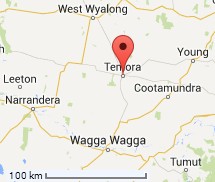
Temora started as a pastoral station in 1847. Gold was discovered later in the area, and a small village established. Temora Post Office opened on 1 February 1874 and was renamed West Temora in 1880 on the same day an existing East Temora office was renamed Temora.

ANNEXATION TO VICTORIA.
Wagga Wagga Advertiser and Riverine Reporter (NSW)
Date: February 21, 1872
Page Number: 2

...
Well, what advantage were their pastoral friends to derive from annexation to their enterprising neighbour ? Their rentals and assessments would be in creased at least sevenfold, which would be simply ruinous; their tenure, short and precarious enough now, would be more precarious still; and they would become subject to the provisions of a Land law framed for the express purpose of making a squatter as great a rarity in the laud as that extinct or mythical monster, the Bunyip. (Cheers and laughter.) "Oh," said their Victorian tempters, echoed by Mr. Shaw, "if that is the only difficulty we will waive it..."
Wagga Wagga Advertiser and Riverine Reporter (NSW)
Date: March 23, 1872
Page Number: 2

What is the Bunyip ? There really is a bunyip, or a Waa-Wee, actually existing not far from us ; and others probably nearer than we imagined. The animal has been seen by many persons, whose veracity is unimpeachable, and whose-intimate acquaintance; with the Fauna of the Murrumbidgee, coupled with, their general intelligence and observation, puts it altogether beyond doubt that in the Midgeon Lagoon, 16 miles north of Narandera, there exists an animal which in every respect tallies with the description of the creature frequently eported as seen in various places. Here is the account of a gentleman who had a quiet half-hours' view of this strange nondescript.
"A few days since, Mr. A., who was driving sheep across country to Melbourne, camped on the Lagoon. He called at my house and asked, what the devil the animal was that we had in our swamp? and proceeded to describe some thing which had alarmed him and the shepherd . I ridiculed his report and he got angry, inviting me to come down and see for myself. I went down early next morning, between 6 and 7 o'clock, accompanied by two other persons,and had not waited long before I heard the sound as of a body rushing rapidly through the water, making a noise as loud as that caused by a North Shore steamer. Looking in the direction of the sound I saw a creature coming through the water with tremendous rapidity; and directing its course immediately towards us. We stood still, deeply interested, and, watched the approach of the animal, which, having, as we presumed, lately risen to the surface, was evidently not aware of our presence. It came on with great swiftness until it was scarcely 30 yards from the edge of the lagoon, when it appeared suddenly to catch sight of us, and stopt instantly. It lay on the water then perfectly still, and I had a splendid view of a creature that surprised me more than anything I had ever before seen in my life. The animal was about half as long again as an ordinary retriever dog, the hair all over its body was jet black and shining, its coat was very long—the hair spreading out on the surface of the water for about 5 inches, and floating loosely as the creature rose and fell by its own motion. I could not detect any tail, and the hair about its head was too long and glossy to admit of my seeing its eyes ; the ears were well marked. If made no noise, but kept its position for half-an-hour, surveying us, no doubt, leisurely, although its visual organs were hidden from us. At length it turned quietly round and swam off easily, without any manifestation of alarm, and we watched it moving leisurely along the surface of the lake until, it was hidden by the distance. We have been greatly exiited by its appearance, and I have offered £20 for its dead body, and £50 if captured alive."
This statement may be relied upon, and there can'be no doubt whatever the gentleman saw all he has described. Could not a party be fitted out to earn the reward, and ennoble Wagga in the annals of Natural History?
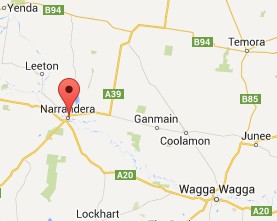
The Narrungderra were the local indigenous people. They were all but destroyed by settlement, disease brought by European settlers, and clashes with the settlers. The last major battle between the indigenous people and European settlers took place near Massacre Island, and is said to have left only one survivor.
Narrandera had its first recorded mention as a pastoral station or "run" (Narrandera Run) in 1848, at which time the property held by Mr Edward Flood comprised approximately 76,800 acres (31,080 ha).
The township developed in the early 1860s. Gillinbah Post Office opened nearby on 1 March 1859 and was replaced by the Narrandera office in 1861. A Gillenbah office was open from 1881 to 1892 and from 1906 to 1941.
The Borough of Narrandera was constituted by proclamation dated 17 March 1885, and gazetted the following day.

07-09-2014
Wagga Wagga Advertiser and Riverine Reporter (NSW)
Date: April 3, 1872
Page Number: 4

Wagga Wagga Advertiser and Riverine Reporter (NSW)
Date: April 3, 1872
Page Number: 4

...
SPORTING.—The close season terminated yesterday, and we are informed by our friend, Mr. Harry Mostyn, that he succeeded in bagging no less than thirteen brace of prime bunyips, five spotted unicorns, and a couple of moas. He also wounded several Cook's River prawns and Botany Bay oysters, but was not able to secure them, owing to the haziness of the weather.

Wagga Wagga Advertiser and Riverine Reporter (NSW)
Date: April 10, 1872
Page Number: 4

THE BUNYIP AGAIN.
The Sydney Morning Herald (NSW)
Date: August 24, 1872
Page Number: 7
The strange animal (says the Wagga Advertiser) reported some time ago as having been seen by Mr. Roberts in the Midgeon Lagoon, near
Narandera, and for whose capture a reward of £50 was offered by that gentleman, has again been seen in the same locality, this
lime by Mr. Nelson, the engineer, late of Wagga, the animal was out of the watar, and a good view was afforded as he floundered
through some fifty yards of shallow water into the depths of the "Dismal Swamp," when he paddled away most vigorously until
out of sight.












































